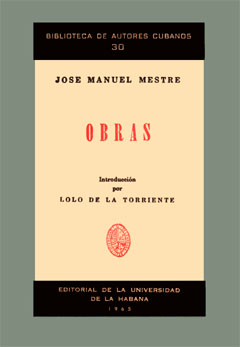2.6.2 The ideas, journalism and oratory of José Manuel Mestre (1832 – 1886)

José Manuel Mestre studied philosophy at the University of Havana, as well as disciplines related to jurisprudence, and eventually practiced law. He was particularly interested in the philosophy of law. He was a disciple of José de la Luz y Caballero, from whom he learned the concepts surrounding the principle of duty as the guideline of human conduct, which were deeply rooted among the younger generation of his time.
His philosophical theses, some of which are expressed in “Considerations on Pleasure and Pain,” which he presented for a professorship at the Faculty of Philosophy, point to the need for unlimited human development in all spheres, which were constricted by slavery and colonialism. He gives due importance to historical research as a way to understand the present and foster the future. His philosophical stance is eclectic in nature, like that of many of his predecessors, such as Félix Varela himself, based on the positivist paradigm.
Like Francisco de Frías, he first embraced annexationism and then reformism, although more as a matter of circumstance, as he apparently never sincerely believed in the viability of reformist demands.
His journalistic work demonstrates a broad cultural background as well as an effective command of language, which reveals his careful reading of both science and literature, at a time when the boundaries between the two profiles were not clearly defined.
His mastery of the language also extended to the field of oratory, where the speech he gave at the Cooper Institute in New York on the occasion of the fourth anniversary of October 10th is of interest. At this time, he was in charge of representing the Republic in Arms in New York, following the death of José Morales Lemus, and the speech was part of a general strategy that proposed diplomatic recognition of the belligerence of the insurgents by the United States, with whose own feat of liberation from English colonialism he drew a parallel.
His work as head of the Republic’s Armed Representation had a conciliatory tone and showed compliance with the authority of Carlos Manuel de Céspedes, not because he particularly sympathized with the leader, but because he understood the importance of discipline and order in successfully carrying out the war effort. However, he never radicalized his thinking in line with the guiding ideals of the War, and when the war failed, he chose to return to his thesis of science as the true engine of social progress.








